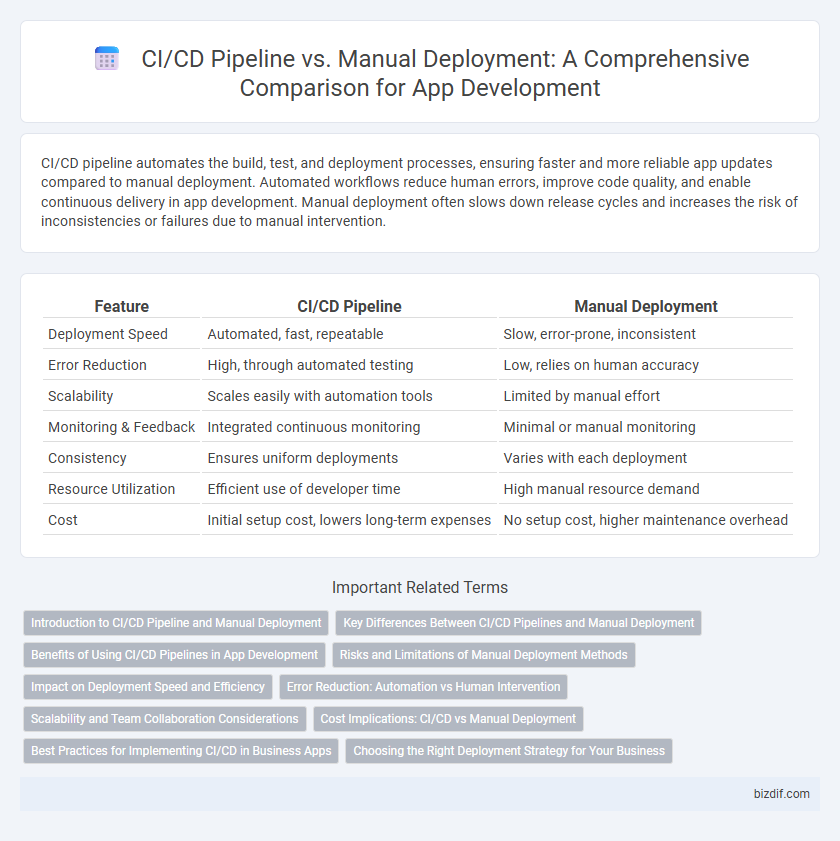CI/CD pipeline automates the build, test, and deployment processes, ensuring faster and more reliable app updates compared to manual deployment. Automated workflows reduce human errors, improve code quality, and enable continuous delivery in app development. Manual deployment often slows down release cycles and increases the risk of inconsistencies or failures due to manual intervention.
Table of Comparison
| Feature | CI/CD Pipeline | Manual Deployment |
|---|---|---|
| Deployment Speed | Automated, fast, repeatable | Slow, error-prone, inconsistent |
| Error Reduction | High, through automated testing | Low, relies on human accuracy |
| Scalability | Scales easily with automation tools | Limited by manual effort |
| Monitoring & Feedback | Integrated continuous monitoring | Minimal or manual monitoring |
| Consistency | Ensures uniform deployments | Varies with each deployment |
| Resource Utilization | Efficient use of developer time | High manual resource demand |
| Cost | Initial setup cost, lowers long-term expenses | No setup cost, higher maintenance overhead |
Introduction to CI/CD Pipeline and Manual Deployment
CI/CD pipeline automates the process of integrating code changes, running tests, and deploying applications, significantly speeding up release cycles and reducing human error. Manual deployment involves developers or operations teams performing each step manually, which can introduce inconsistencies and delays. Leveraging CI/CD pipelines enhances application reliability and promotes continuous delivery in modern app development workflows.
Key Differences Between CI/CD Pipelines and Manual Deployment
CI/CD pipelines automate the integration, testing, and deployment processes, ensuring faster code delivery and higher consistency compared to manual deployment. Manual deployment involves repetitive and error-prone tasks that delay releases and increase risks of configuration discrepancies. Key differences include automation level, deployment speed, error reduction, and continuous feedback integration, making CI/CD pipelines essential for modern agile app development.
Benefits of Using CI/CD Pipelines in App Development
CI/CD pipelines automate testing and deployment processes, significantly reducing human error and accelerating release cycles in app development. They enhance code quality through continuous integration, ensuring that every change is automatically tested and merged, leading to more reliable and maintainable applications. Automated pipelines also enable faster feedback loops, allowing development teams to identify and fix issues early, improving overall efficiency and user satisfaction.
Risks and Limitations of Manual Deployment Methods
Manual deployment methods in app development introduce significant risks such as human error, inconsistent release processes, and slower delivery times. These limitations increase the likelihood of downtime, configuration mistakes, and difficulty in tracking deployment history. Unlike CI/CD pipelines, manual deployments lack automation, reducing scalability and complicating rollback procedures.
Impact on Deployment Speed and Efficiency
CI/CD pipelines automate the build, test, and deployment processes, significantly accelerating deployment speed by enabling continuous integration and continuous delivery. Manual deployment often introduces delays due to human intervention, increasing the risk of errors and inefficiencies. Implementing a CI/CD pipeline enhances efficiency by ensuring consistent, repeatable deployments with faster feedback loops in app development.
Error Reduction: Automation vs Human Intervention
Automation in CI/CD pipelines significantly reduces deployment errors by eliminating manual steps, ensuring consistent and repeatable processes. Human intervention in manual deployment increases the risk of mistakes due to oversight, misconfiguration, or fatigue. Continuous integration and continuous deployment tools provide real-time error detection and rollback mechanisms, enhancing overall software quality and delivery speed.
Scalability and Team Collaboration Considerations
CI/CD pipelines enable scalable app development by automating testing and deployment, reducing errors and allowing teams to collaborate seamlessly through version control integration and real-time feedback. Manual deployment often limits scalability due to time-consuming processes and higher risks of human error, impeding effective collaboration among diverse development teams. Leveraging CI/CD pipelines enhances coordination, accelerates release cycles, and supports the growing complexity of applications in dynamic development environments.
Cost Implications: CI/CD vs Manual Deployment
CI/CD pipelines reduce long-term costs by automating testing, integration, and deployment processes, minimizing human errors and accelerating release cycles for app development teams. Manual deployment incurs higher labor costs due to repetitive tasks, increased risk of deployment failures, and extended downtime leading to potential revenue loss. Investing in CI/CD infrastructure enables scalable, efficient workflows that lower operational expenses compared to manual methods.
Best Practices for Implementing CI/CD in Business Apps
Implementing CI/CD pipelines in business app development accelerates delivery and enhances code quality by automating testing, integration, and deployment processes. Best practices include version control integration, automated unit and integration testing, environment consistency via containerization, and continuous monitoring post-deployment. This approach reduces human error, enables rapid feedback loops, and promotes collaboration among development, QA, and operations teams.
Choosing the Right Deployment Strategy for Your Business
Choosing the right deployment strategy depends on your business's scalability, speed requirements, and error tolerance. CI/CD pipelines automate build, test, and deployment processes, reducing human error and accelerating delivery, ideal for fast-paced development cycles. Manual deployment offers greater control and flexibility for small-scale or less frequent updates but increases the risk of inconsistency and delays in production.
CI/CD Pipeline vs Manual Deployment Infographic

 bizdif.com
bizdif.com